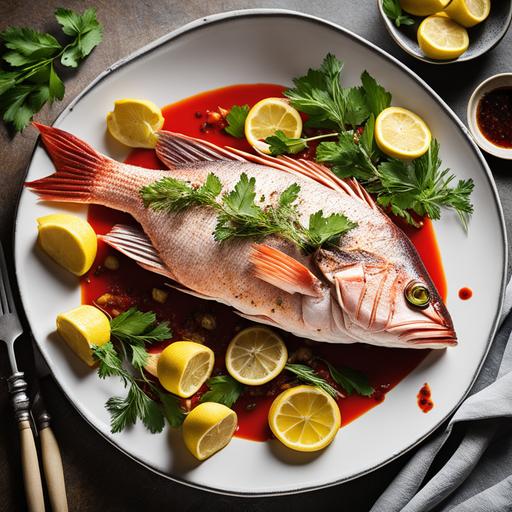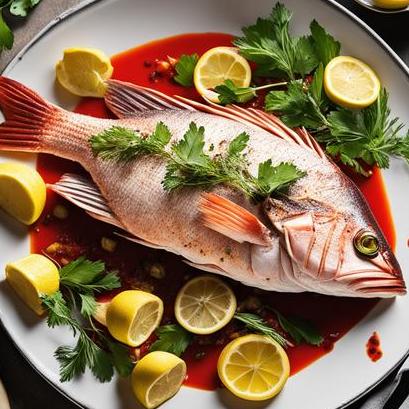
Whole Red Snapper Oven Recipe: A Comprehensive Guide
Delicious, flavorful, and visually stunning, a whole red snapper cooked in the oven is an impressive dish that will leave your guests in awe. In this comprehensive and in-depth article, we will explore every aspect of cooking a whole red snapper in the oven, from selecting the perfect fish to serving it in the most exquisite way possible.
Cooking a whole red snapper in the oven is a delightful culinary adventure that combines technique, flavors, and presentation. This iconic dish is not only a treat for your taste buds but also a feast for your eyes. With the right knowledge and guidance, you can easily master this impressive recipe and bring a taste of the ocean to your dining table.
Food Science and Culinary Details
Understanding the science behind cooking fish is crucial to ensure optimal flavors and textures. Red snapper, known for its firm texture and mild, sweet flavor, requires a delicate cooking method to retain its unique characteristics.
When exposed to heat, the proteins in the fish undergo denaturation, causing the flesh to firm up and turn opaque. Red snapper has a delicate balance of moisture and tenderness, making it important to avoid overcooking, which can result in a dry and rubbery texture.
Selection and Cleaning
Choosing the right fish is a vital step in preparing any seafood dish. Look for whole red snapper with clear, bright eyes and shiny, metallic skin. The fish should have a fresh, mild odor reminiscent of the ocean. Avoid fish with dull eyes, a strong fishy smell, or signs of browning or bruising.
Before preparing the fish, it is important to clean it thoroughly. Rinse the whole red snapper under cold water, both inside and out, to remove any traces of blood, scales, or impurities. Pat it dry with a paper towel to ensure a good sear and prevent excess moisture during cooking.
Preparation and Tips

Preparing a whole red snapper for the oven requires a few essential steps to enhance its flavors and ensure even cooking. Here are some tips to consider:
-
Scaling: Use the back of a knife to gently scale the fish, removing any remaining scales. This step prevents the scales from peeling off during cooking and ending up in the dish. Scaling also allows for better seasoning and absorption of flavors.
-
Score the skin: Make shallow diagonal cuts on both sides of the fish. This helps the heat penetrate evenly, resulting in a crispy skin. Additionally, scoring allows the marinade or seasoning to reach the flesh, creating a well-balanced flavor profile.
-
Season generously: Season the inside and outside of the fish with salt, pepper, and any other desired spices or herbs. Red snapper beautifully absorbs flavors, so don’t hesitate to be liberal with your seasonings. Classic options include garlic, thyme, rosemary, and lemon zest.
Variations
While a simple and classic preparation is delightful, experimenting with flavors can take your red snapper to new heights. Here are a few variations to consider:
-
Asian-inspired: Marinate the red snapper in a mixture of soy sauce, ginger, garlic, and sesame oil. Serve it with steamed rice, bok choy, and a drizzle of soy-ginger glaze for a mouthwatering fusion dish.
-
Mediterranean twist: Stuff the fish cavity with a mixture of chopped tomatoes, olives, capers, garlic, and fresh herbs like basil or parsley. Roast until the fish is tender and flavors are concentrated. Serve alongside roasted potatoes and a green salad.
-
Spicy Caribbean: Prepare a fiery marinade by blending scotch bonnet peppers, lime juice, allspice, thyme, and brown sugar. Allow the fish to soak up the flavors before grilling or baking it. Serve with a side of coconut rice and grilled plantains.
Feel free to use these variations as a starting point and let your imagination run wild. The versatility of red snapper allows for endless creativity in the kitchen.
Doneness Checks

Determining the doneness of a whole red snapper can be challenging, as it requires careful observation and experience. Here are some signs to look for:
-
Flesh texture: The flesh should be moist and flake easily with a fork. Overcooked fish will become dry and will lose its natural tenderness.
-
Internal temperature: A red snapper is fully cooked when the internal temperature reaches 145°F (63°C). Use a meat thermometer to ensure accuracy. Insert it into the thickest part of the flesh without touching the bone for an accurate reading.
-
Eye color: The eyes of a cooked red snapper turn white when done. This visual cue is a traditional way to determine the fish’s doneness.
Remember, it’s better to slightly undercook the fish and let residual heat finish the cooking process than to overcook it and end up with a disappointing result.
Recipe: Whole Red Snapper Oven Delight
Ingredients:
-
1 whole red snapper (about 2 pounds)
-
Salt and pepper
-
2 garlic cloves, minced
-
Zest of 1 lemon
-
Fresh thyme sprigs
-
2 tablespoons olive oil
Instructions:
-
Preheat your oven to 400°F (200°C). Line a baking sheet with parchment paper or aluminum foil for easy cleanup.
-
Rinse the red snapper under cold water and pat dry using a paper towel.
-
Score the skin on both sides of the fish, making shallow diagonal cuts. This will help with even cooking and allow the marinade to penetrate the flesh.
-
Generously season the inside and outside of the fish with salt, pepper, minced garlic, and lemon zest. Place a few sprigs of fresh thyme inside the cavity.
-
Drizzle the olive oil over the fish, ensuring it is coated evenly.
-
Transfer the seasoned red snapper onto the prepared baking sheet. If desired, place lemon slices or additional herbs on top for decoration.
-
Place the baking sheet in the preheated oven and bake for approximately 15-20 minutes, depending on the size of the fish. Check for doneness by gently pressing a fork into the flesh. If it flakes easily, the fish is ready.
-
Once cooked, remove the red snapper from the oven and let it rest for a few minutes before serving. This allows the juices to redistribute, ensuring a moist and flavorful result.
Serving Suggestions
A beautifully cooked whole red snapper is a centerpiece-worthy dish that deserves an equally impressive presentation. Here are some serving suggestions to elevate your culinary creation:
-
Garnish: Arrange fresh herbs, such as parsley or cilantro, around the fish. Sprinkle some lemon zest on top for an extra pop of flavor and color.
-
Accompaniments: Serve with steamed vegetables, roasted potatoes, or a vibrant salad. The freshness and simplicity of the sides will complement the bold flavors of the red snapper.
-
Sauces: Offer a variety of dipping sauces to enhance the dining experience. Classic choices include tartar sauce, lemon butter, or a tangy aioli.
-
Family-style: Place the cooked whole red snapper on a large platter, surrounded by your favorite sides. Allow guests to help themselves to generous portions, creating a communal and celebratory atmosphere.
In Conclusion
Cooking a whole red snapper in the oven is an art that combines culinary technique, flavors, and presentation. With the detailed information and tips provided in this article, you are well-equipped to embark on this delicious journey.
Remember to select the freshest fish, clean it thoroughly, and season it generously. Choose from the classic recipe or explore various flavor variations to suit your palate. Utilize doneness checks to ensure a perfectly cooked red snapper, and don’t forget to present your masterpiece with pride.
By immersing yourself in the food science, culinary details, and various aspects of this whole red snapper oven recipe, you will take your culinary skills to new heights, impressing your guests and creating unforgettable dining experiences. Enjoy the process, embrace experimentation, and savor the delightful rewards of your efforts.



